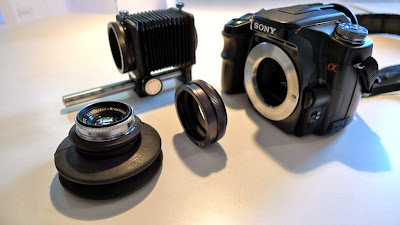Extension bellows fits between the camera lens and the camera body and functions on the same principle of extension tubes. They are superior to extension tubes because they provide the ability to vary the extension to control the amount of magnification.
 |
| Macro Bellows |
Most major camera manufacturers have bellows systems and there are some made by third party manufacturers which work with most camera bodies by using adapter rings. Bellows systems come from the basic bellows unit with no electrical contacts to the ones that have advanced features like providing full electrical communication between the camera body and the lens (when using same brand camera and lens), ones with controls to make very fine adjustments for precision focusing, units equipped with focusing rails, the ability to move both front and back standards and ability to make tilt/shift movements to re-position the depth of field as needed etc.
Tips for Using Bellows for Macro Photography
- Bellows units could be quite cumbersome to use; and it is strongly recommended to use a strong, sturdy tripod when shooting with bellows.
- With Bellows systems the minimum magnification is usually around 1:1 or greater so it can only be used to photograph tiny objects.
- Better quality bellows units will be fitted with a focusing rail and will have the ability to move either the front or back element. It is recommended that you first set the desired magnification and then focus by moving the whole bellows assembly nearer or farther from the subject.
- There are special lenses available in the market designed specifically to be used with bellows units; they are known as bellows macro lenses or simply lens heads; they are available in a range of focal lengths from 12.5mm to 135mm (Some of them come with automatic diaphragms). They could provide up to 20X magnification. The shorter the focal length the greater the magnification is at a given extension and vice versa. Longer focal length lenses could focus at infinity while it is not possible with shorter focal length lenses. In general these special lenses deliver excellent image quality when compared to other lenses.
- Good quality enlarging lenses work well with bellows and produce excellent results.
- If you plan to use normal (Ordinary) lenses on bellows use a lens reverse ring to reverse mount the lens reversed on the bellows for better image quality.
- If the lens used (when using normal lenses) have floating elements in them (macro or fast wide angle lenses) set focus to close focus and not at infinity for better image quality.
Advantages of Using Bellows for Macro Photography
- Can easily vary the extension to adjust the magnification.
- Greater range of extension (magnification) possible than other methods.
- Bellows with built in high quality focusing rails make critical focusing at high magnification a lot easier with a "focusing rail" that moves the camera and the lens together as one unit.
- Bellows provides serious advantages for people who do a lot of focus stacking.
With other kinds of macro systems (either via a conventional macro lens's standard focus collar or using focus rails) when you take several pictures at different depths the front of the lens moves causing a change in perspective. This change in perspective produces strange artifacts commonly referred to as "fringing" or "echos" (they appear as weird little borders around edges). Advanced bellows systems like the Nikon PB-4 or PB-6 bellows allows you to use a focusing technique called "bellows draw". Here the front of the lens stays in place and stacking is done by moving only the rear standard; as the lens in front remains in place there is no perspective shift and as a result you get perfect, fringe free stacks.
Disadvantages of Using Bellows for Macro Photography
- Bellows units are comparatively expensive than other macro options except a dedicated macro lens.
- Large minimum extension, minimum magnification is at least 1:1 in most cases.
- Heavy and cumbersome to be used in the field.
- Bellows assembly is delicate and very fragile and is easily damaged if not treated with care.
Here are some exemplary macro shots for your inspiration.
Related Reading









Post a Comment